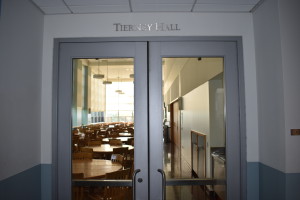Dhilan Lavu ‘21, Peter Woodville ‘21:
EA is considering changing to an “all in” pre-paid lunch system, which would be a massive departure from the item by item payment we have now. Paul Sanders, EA’s Assistant Head of School gave an in depth explanation of what an “all in” system entails. “At the beginning of the year families pay for lunch. Students, and teachers too, can just go in, take what they like, eat what they like, clean up and leave,” he says. However, Sanders stressed that EA is only looking into this radical change and it may not be implemented at all. “I should say that there’s no change that’s definite, we’re just investigating.”
One of the several advantages of the “all in” lunch system is that it would open up the cafeteria and make it less crowded. “You can kind of spread out a little bit, nobody has to spend valuable time waiting in line,” says Sanders. Although this change will be drastic, it already seems to have the support of the EA community. In a poll comprised of 25 students, 76% said they support the plan with many citing the same reasons as Sanders. “That would be so much better, it would cut down the lines, and it would be like a buffet and students could take what they wanted,” says Petey Dugery ‘21. Mike Wennemer ‘21 is in agreement. “It would be much more efficient and quicker. People would get their lunch and get out without a line.”
However some students are skeptical about the consequences of allowing students to take as much food as they would like. “I’d rather stick with the old system, there are certain people that would abuse this system,” says Tommy Kan ‘21. Sanders addressed this potential flaw. “I’m of the opinion that like after maybe day one or day two of a sixth grader grabbing a whole bunch of cookies that eventually people would probably pretty quickly actually settle into healthy habits. “Health needs to be part of the consideration,” he notes. Sanders also addressed another question on many students’ minds: how much would the down payment at the beginning of the year be? “The average (a student spends buying lunch) looks like it’s about $6.50, so what we want to do is try to find out if a plan like this could actually make it slightly less expensive.” This means that if you are spending $6.50 or more each day at lunch this plan would save you money. Sanders also gave details regarding when the plan would be implemented,“We would have to make that decision pretty early in the calendar year 2018 so that we can get the planning done for the families so they could make the adjustments.” But again he stressed that nothing is set in stone, explaining, “I can’t say it enough we’re just investigating.”

Sanders and Head of School T.J. Locke have been visiting different schools that have implemented an “all in” system and drawing inspiration from them. He praised one school with the system.“I go in for lunch and it was the most pleasant (thing), the food was great…. and the tone was just so much calmer than any Middle or Upper School dining room I’ve ever seen.
Perhaps the biggest concern for students was that they would be forced to buy lunch every day because there are no flexible meal plans. All students would pay the same amount of money even if they bring lunch most days. “I would disagree with [the “all in” plan] because it forces kids to an extreme where they have to buy lunch every day,” says Bo Aldridge ‘21.
Perhaps an even bigger concern is students who cannot buy because of allergies. Sanders is not yet sure whether Episcopal would charge every student, or let kids with allergies opt out. “It’s a big decision we would have to make if we were to make a shift like this.” Sanders understands where students are coming from with their concerns saying, “It’s not too hard to see the downsides, so if we can come up with an approach that helps us get around the downsides, well maybe we should do it. We’re not at a school that settles for pretty good, so if we can do better we want to do better.”